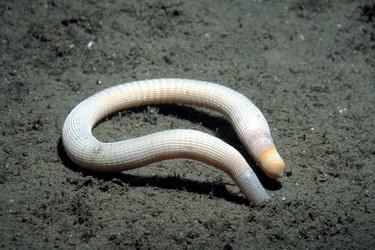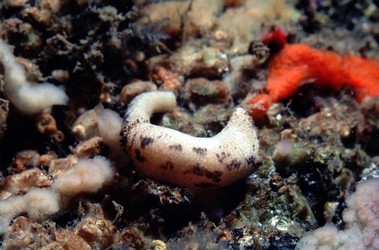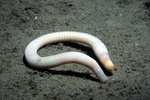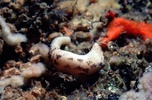Sipuncula
Peanut Worms



This tree diagram shows the relationships between several groups of organisms.
The root of the current tree connects the organisms featured in this tree to their containing group and the rest of the Tree of Life. The basal branching point in the tree represents the ancestor of the other groups in the tree. This ancestor diversified over time into several descendent subgroups, which are represented as internal nodes and terminal taxa to the right.

You can click on the root to travel down the Tree of Life all the way to the root of all Life, and you can click on the names of descendent subgroups to travel up the Tree of Life all the way to individual species.
For more information on ToL tree formatting, please see Interpreting the Tree or Classification. To learn more about phylogenetic trees, please visit our Phylogenetic Biology pages.
close boxDiscussion of Phylogenetic Relationships
Sipunculidea (Sipunculidae , Golfingiiformes), Sipunculidae (Sipunculus , Xenosiphon , Siphonosoma , Siphonomecus , Phascolopsis), and Phascolosomatidae (Phascolosoma , Apionsoma , Antillesoma) of Cutler (1994) are most likely not monophyletic (Maxmena et al. 2003, Schulze et al. 2007).
References
Cutler, E. B. 1994. The Sipuncula, their systematics, biology, and evolution. Cornell University Press, Ithaca, NY.
Cutler, E. B. and P. E. Gibbs. 1985. A phylogenetic analysis of higher taxa in the phylum Sipuncula. Systematic Zoology 34:162-173.
Edmonds, S. J. 2000. Phylum Sipuncula. Pages 375–400 in: Polychaetes & Allies: The Southern Synthesis. Fauna of Australia, vol. 4A, Polychaeta, Myzostomida, Pogonophora, Echiura, Sipuncula. P. L. Beesley, G.J.B. Ross, and C.J. Glasby, eds. CSIRO Publishing, Melbourne.
Ferrier, D. and P. W. H. Holland. 2001. Sipunculan ParaHox genes. Evol. Dev. 3:263-70
Huang, D. Y., J.-Y. Chen, J. Vannier, and J. I. Saiz Salinas. 2004. Early Cambrian sipunculan worms from southwest China. Proceedings of the Royal Society of London Series B 271(1549):1671-1676.
KennetLundin, K. and C.Schander. 2003. Epidermal ciliary ultrastructure of adult and larval sipunculids (Sipunculida). Acta Zoologica 84(2):113-119.
Maxmena, A. B., B. F. King, E. B. Cutler and G. Giribet. 2003. Evolutionary relationships within the protostome phylum Sipuncula: a molecular analysis of ribosomal genes and histone H3 sequence data. Molecular Phylogenetics and Evolution 27(3):489-503.
Rice, M. E. 1985. Sipuncula: developmental evidence for phylogenetic inference. Pages 274-296 in The Origins and Relationships of Lower Invertebrates. S. C. Morris, J. D. George, R. Gibson and H. M. Platt, eds. Oxford University Press, Oxford.
Rice, M. E. 1993. Sipuncula. Pages 238–325 in: Microscopic Anatomy of Invertebrates, Vol. 12: Onychophora, Chilopoda, and Lesser Protostomata. F. W. Harrison and M. E. Rice, eds. Wiley-Liss, New York.
Schulze, A., E. B. Cutler and G. Giribet. 2005. Reconstructing the phylogeny of the Sipuncula. Hydrobiologia 535/536:277–296.
Schulze, A., E. B. Cutler and G. Giribet. 2007. Phylogeny of sipunculan worms: A combined analysis of four gene regions and morphology. Molecular Phylogenetics and Evolution 42(1):171-192.
Information on the Internet
- Edward B. Cutler's home page has links to more information about Sipuncula.
Title Illustrations

| Scientific Name | Sipunculus nudus |
|---|---|
| Location | Azores |
| Specimen Condition | Live Specimen |
| Identified By | Jose Ignazio Saiz Salinas (from specimens) |
| Copyright |
© Peter Wirtz

|
| Scientific Name | Phascolosoma stephensoni |
|---|---|
| Location | Azores |
| Specimen Condition | Live Specimen |
| Identified By | Jose Ignazio Saiz Salinas (from specimens) |
| Copyright |
© Peter Wirtz

|
About This Page
Page copyright © 2008
 Page: Tree of Life
Sipuncula. Peanut Worms.
The TEXT of this page is licensed under the
Creative Commons Attribution-NonCommercial License - Version 3.0. Note that images and other media
featured on this page are each governed by their own license, and they may or may not be available
for reuse. Click on an image or a media link to access the media data window, which provides the
relevant licensing information. For the general terms and conditions of ToL material reuse and
redistribution, please see the Tree of Life Copyright
Policies.
Page: Tree of Life
Sipuncula. Peanut Worms.
The TEXT of this page is licensed under the
Creative Commons Attribution-NonCommercial License - Version 3.0. Note that images and other media
featured on this page are each governed by their own license, and they may or may not be available
for reuse. Click on an image or a media link to access the media data window, which provides the
relevant licensing information. For the general terms and conditions of ToL material reuse and
redistribution, please see the Tree of Life Copyright
Policies.
- Content changed 09 January 2008
Citing this page:
Tree of Life Web Project. 2008. Sipuncula. Peanut Worms. Version 09 January 2008 (temporary). http://tolweb.org/Sipuncula/2487/2008.01.09 in The Tree of Life Web Project, http://tolweb.org/









 Go to quick links
Go to quick search
Go to navigation for this section of the ToL site
Go to detailed links for the ToL site
Go to quick links
Go to quick search
Go to navigation for this section of the ToL site
Go to detailed links for the ToL site